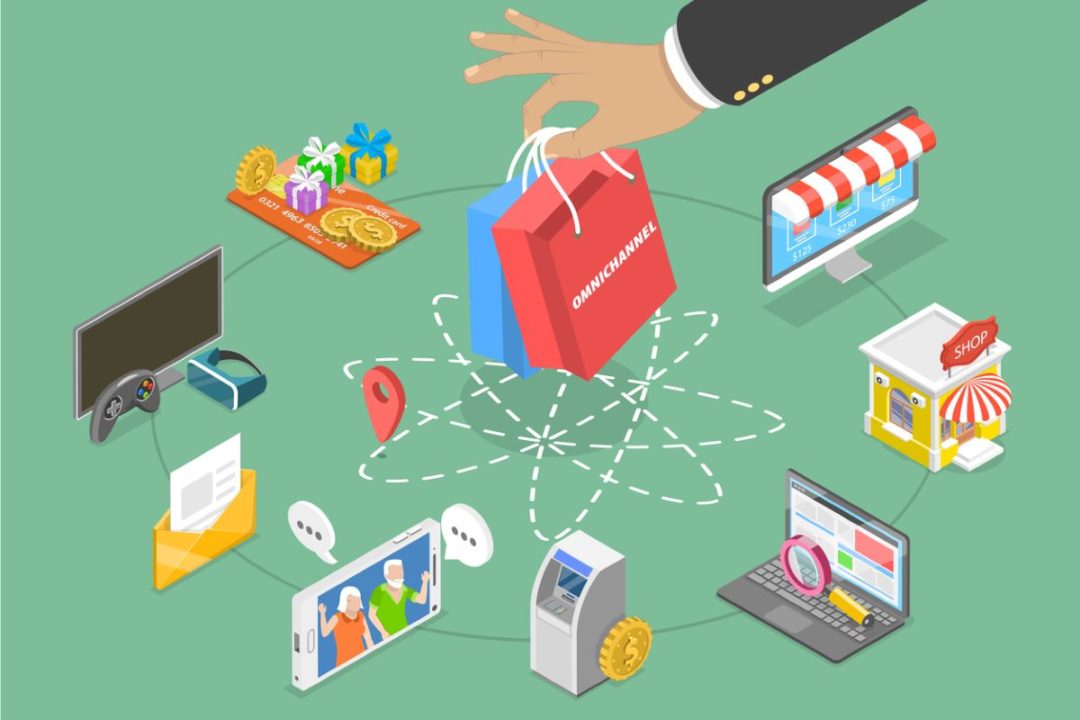It’s no secret that omnichannel marketing strategies deliver results. According to McKinsey, a fully-fleshed, well-thought-out omnichannel strategy can increase a store’s revenue by up to 15%. Similarly, Think with Google found that omnichannel marketing increased store visits by up to 80%.
Clearly, there’s something to be said for adopting an omnichannel strategy rather than a single-channel one. However, many brands that try to do so make mistakes that derail their efforts. Here are a few typical problems marketers face in their omnichannel strategies and how to fix them.
Omnichannel Marketing: A Definition
Omnichannel marketing involves using multiple marketing and sales channels to connect with clients. As customers interact with your brand via each channel, your omnichannel technology stack records the interaction and saves the data for future communications.
A well-developed omnichannel marketing strategy provides a seamless, cohesive customer experience. Think of it in terms of a conversation with a friend.
In a conversation, two or more people discuss a topic, each interaction building upon one another. Once the conversation ends, you don’t forget it and “redo” the conversation later. Instead, the participants recall the prior communication and use it as a starting point for future ones.
Omnichannel marketing involves a similar process. The various channels you use to interact with clients store and share each interaction, allowing brands to continue the customer’s experience even when they switch platforms.
Amazon is an excellent example of a company incorporating a cohesive omnichannel strategy. When you shop on Amazon’s website, the company records your browsing and purchase activity. If you switch from the website to Amazon’s app, the company will recommend items based on your website visit. Customers who live within driving distance of an Amazon store can pick up items they order online or arrange for their delivery.
Omnichannel Technology Mistakes Can Derail Your Strategy
While omnichannel marketing is relatively easy to understand, it’s not as straightforward to implement. Brands encounter a few problems that can derail their efforts, reducing the effectiveness of their strategy.
1. Using the Same Content for Every Social Media Channel
Omnichannel marketing requires using multiple platforms, including social media, to communicate with your customers. Most companies that use social media to promote their brand will have various social media accounts.
Maintaining multiple social media channels can be draining, especially for companies that don’t have a significantly-sized marketing team to manage each one. That’s why some brands post the same message on all platforms. They don’t have the time (or the staff) to repurpose the content. However, reposting the same content across different channels creates a bad user experience for those who follow your accounts on multiple accounts.
Rather than posting the same message to your Facebook, Instagram, and Twitter followers, change the wording to better reflect how users engage with the platform. For instance, Instagram is a place for pictures and short clips. People who scroll through their Instagram feeds aren’t likely to read a lengthy text caption unless your graphic is exceptionally compelling and they want to learn more.
Twitter is best for short-text content that readers can quickly grasp before moving on to the next post. It’s not suitable for long-form content. Instead, you can write a few sentences that quickly capture the user’s attention, then include a shortened link to the long-form content you’re promoting.
Understanding how users interact with each channel can help you determine how to present content that aligns with the platforms you’re using. When your followers see you’re not simply auto-posting but actively creating content that aligns with the platform’s design, they’ll be more likely to engage with it.
If time and staff are an issue for your posting strategy, consider using a social media marketing tool like Hootsuite. Hootsuite allows you to create social media posts in a convenient all-in-one tool for various platforms. Additionally, their auto-scheduling feature will enable you to plan your posts in advance.
2. Failing to Understand How Your Audience Interacts with Your Brand Across Different Platforms
How your clients engage with your brand will differ across different platforms. You’ll need to consider that when you devise your omnichannel strategy.
For instance, social media is excellent for establishing brand awareness. When clients regularly see your posts, their knowledge of your company will grow. However, it’s usually not the best source for sales. Typically, people who go on social media platforms aren’t shopping. Instead, they want to see what their friends and family are up to and share information about themselves. They may see your post, but that doesn’t mean they’ll follow it and make a purchase.

Other channels, like PPC ads, email, and SMS, are more likely to result in a sale. You can intertwine prior customer interactions with your brand through those channels to encourage buyers to purchase.
For instance, if a customer recently browsed your e-commerce website, you might send them a retargeted email of the items they looked at and a special one-time discount to buy. You could take a similar approach through an SMS text.
3. Not Unifying Your Customer Data
In an omnichannel marketing strategy, customer data is king. Without it, you won’t see the results you’d like from your marketing techniques.
Companies adopting an omnichannel marketing strategy can obtain customer data from their platforms, including their website, social media accounts, email and SMS signups, and physical in-store visits. To make the most of the data you obtain, store it in a single platform. That way, you can determine the next steps to move your clients through your purchasing funnel.
Remember that the older your data is, the more likely it is to be outdated. For instance, a client that moves to a different area will change their address and perhaps their phone number. Over time, they might stop using a particular social media account or switch to a different platform. Their interests or needs could change, making your products or services irrelevant.
It’s good practice to reach out to your clients yearly and ask if they want to update their communication preferences or contact details. That way, you stay on top of their contact information, and your data will remain accurate.
You should take care to remove any outdated information quickly. For instance, if you notice a client hasn’t opened your SMS texts in months, sending a text asking if they want to remain on your subscriber list is a good idea. If they don’t respond, they’re no longer engaged with your company, and you should remove their number from your database.
Companies that have multiple team members working on different parts of an omnichannel marketing strategy should ensure they have access to the same data. Disconnects between other channels can hamper your omnichannel technology strategy and lessen the benefits you receive from them.
4. Failing to Analyze Your Metrics as a Whole
Each channel in your omnichannel marketing strategy will provide you with different metrics. For instance, your website will inform you about visits, referrers, bounce rates, and client interactions across multiple pages. Social media can tell you how many people saw your post, who “liked” it, shared it, and left comments.
Email allows you to measure open rate, plus other engagement statistics like clicks to your website and conversions. SMS provides its own analytics, like reads, deliverability, and replies.
Rather than looking at your analytics individually, examine them in totality. Try understanding how clients interact with your brand across various touchpoints rather than simply one channel. The information you glean can help you assess your client’s typical buying journey and understand how every channel impacts it.
For instance, you might look at the analytics from your Instagram account and falsely assume that it’s not resulting in any sales, so it must not be worth maintaining. However, in reality, new clients are learning about your company through your Instagram account and going directly to your website when they want something you have to offer.
Organizations with a physical presence should also analyze customer visits and interactions. In-person visits can be harder to track, especially if you operate a retail store. However, you can encourage in-store clients to share more about themselves by offering rewards programs or opportunities to save if they sign up for your email or SMS alerts during the purchase process.
5. Not Taking Action on Your Data
Implementing an omnichannel marketing strategy will teach you a lot about your clients. However, it’s essentially useless if you don’t use the data to your advantage. You should be doing more than just gathering and storing statistics.
Properly assessing your data requires some creativity. The more information you have about your clients via various channels, the more you can use it to your advantage.
For instance, someone visiting your website for the first time may arrive in several ways: through a search on Google or Bing, by clicking on an ad, or through your social media accounts. You should see how they came across your site through your analytics tool, like Google Analytics.
Google Analytics will tell you the keywords your customers used to find your site. It can also tell if their visit came from a social media click or another referrer.
To get the most out of your data, sit down and map the interactions clients have across your different channels. If you have identifiable, first-party data, you should be able to learn quite a lot.
If measuring and analyzing data isn’t your thing, you could consider hiring someone to do it for you. A marketing strategist skilled in examining customer data can help you understand how people interact with your brand and note specific techniques to deploy for higher engagement and ultimately, more conversions.
When You Use Omnichannel Technology Appropriately, You’ll See Results
A proper omnichannel marketing strategy is more than a simple brand presence across different channels. It involves connecting the dots and providing customers with a seamless, natural, and genuine experience.
When you deploy your omnichannel technology properly, you’ll form stronger connections with clients that can help you increase sales and brand loyalty. Avoid the mistakes some brands make when following an omnichannel strategy for the best results.
Are you looking for a platform to manage your email and SMS omnichannel marketing strategy? Contact Consumers is the right choice. Learn more about our comprehensive email and SMS marketing solutions.




